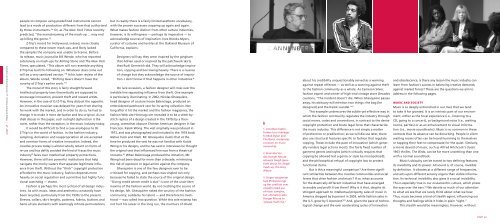Testimony of David Wolfe, Creative Director The ... - Public Knowledge
Testimony of David Wolfe, Creative Director The ... - Public Knowledge
Testimony of David Wolfe, Creative Director The ... - Public Knowledge
Create successful ePaper yourself
Turn your PDF publications into a flip-book with our unique Google optimized e-Paper software.
E s s a y s : M u s i c a n d F a s h i o n<br />
people to compose using predefined instruments cannot<br />
but in reality there is a fairly limited aesthetic vocabulary,<br />
lead to a mode <strong>of</strong> production different from that authorized<br />
with the proven successes cropping up again and again.<br />
by those instruments.” 4 Or, as <strong>The</strong> New York Times recently<br />
What makes fashion distinct from other culture industries,<br />
predicted, “the mainstreaming <strong>of</strong> the mash-up … may end<br />
up killing the genre.” 5<br />
however, is its willingness — perhaps its imperative — to<br />
acknowledge sources <strong>of</strong> inspiration. Inez Brooks-Myers,<br />
Z-Trip’s record for Hollywood, indeed, more closely<br />
curator <strong>of</strong> costume and textiles at the Oakland Museum <strong>of</strong><br />
compared to these newer mash-ups, and likely lacked<br />
California, explains:<br />
the samples the company was unable to license. Before<br />
its release, music journalist Bill Werde, who has reported<br />
Designers will say they were inspired by the gingham<br />
extensively on mash-ups for Rolling Stone and <strong>The</strong> New York<br />
that Adrian used or inspired by the patchwork skirts<br />
page 48 | Ready to Share: Fashion & the Ownership <strong>of</strong> Creativity<br />
Times, speculated, “This album will not resemble anything<br />
Z-Trip has built his following on. Whatever does come out<br />
will be a very sanitized version.” 6 In his later review <strong>of</strong> the<br />
album, Werde noted, “Shifting Gears doesn’t have the<br />
novelty <strong>of</strong> Z-Trip’s earlier work.” 7<br />
<strong>The</strong> moral <strong>of</strong> this story is fairly straightforward.<br />
Intellectual property laws theoretically are supposed to<br />
encourage innovation, prevent theft and reward artists.<br />
However, in the case <strong>of</strong> DJ Z-Trip, they did just the opposite.<br />
An innovative musician was delayed for years from sharing<br />
his work with the market, and in order to do so, he had to<br />
change it to make it more derivative and less original. As we<br />
shall discuss in this paper, such outright dysfunction is the<br />
norm, rather than the exception, in the music industry today.<br />
It would be difficult to find a case analogous to DJ<br />
Z-Trip’s in the world <strong>of</strong> fashion. In the fashion industry,<br />
sampling, derivation and reappropriation all are accepted<br />
and common forms <strong>of</strong> creative innovation. Indeed, the<br />
creative process today is almost wholly reliant on forms <strong>of</strong><br />
re-use and has deftly avoided the kind <strong>of</strong> fracas the music<br />
industry 8 faces over intellectual property protections.<br />
However, there still are powerful institutions that help<br />
navigate the murky waters that separate legitimate influence<br />
from theft. Without the “thick” copyright protection<br />
afforded to the music industry, fashion depends more<br />
heavily on social regulation and a primitive but highly functional<br />
watchdog — shame.<br />
Fashion is perhaps the most cyclical <strong>of</strong> all design industries.<br />
As with music, ideas and aesthetics constantly have<br />
been recycled, particularly from the 1930s to the present.<br />
Sleeves, collars, skirt lengths, patterns, fabrics, buttons and<br />
hems all are elements with seemingly infinite permutations,<br />
that Rudi Gernreich did. <strong>The</strong>y will acknowledge inspiration,<br />
copying and borrowing heavily. <strong>The</strong>re is a nuance<br />
<strong>of</strong> change but they acknowledge the source <strong>of</strong> inspiration.<br />
I don’t know if that happens in other industries. 9<br />
On rare occasions, a fashion designer will cross over the<br />
invisible line separating influence from theft. One example<br />
is particularly illuminating. In 2002, Nicolas Ghesquière,<br />
head designer <strong>of</strong> couture house Balenciaga, produced an<br />
embroidered patchwork vest for its spring collection. Not<br />
long after it hit the market and the fashion magazines, the<br />
fashion Web site Hintmag.com revealed it to be a stitch-bystitch<br />
replica <strong>of</strong> a design created in the 1970s by a thenyoung,<br />
somewhat obscure Chinese American designer in San<br />
Francisco, Kaisik Wong. <strong>The</strong> vest originally was produced in<br />
1973, and was photographed and included in the 1974 book<br />
Native Funk and Flash. Mr. Ghesquière claims that at the<br />
time he produced the vest he was not familiar with Kaisik<br />
Wong or his designs, and he has said in interviews he thought<br />
the original vest that influenced him was from a theatrical<br />
costume. 10 When Balenciaga produced the imitation, Mr.<br />
Wong had been dead for more than a decade, minimizing<br />
the risk <strong>of</strong> exposure or legal action against the company.<br />
Ghesquière is one <strong>of</strong> the few designers ever to be<br />
criticized for copying, and perhaps was singled out only<br />
because he failed to state the source <strong>of</strong> the original design.<br />
“Giving credit where credit is due” is one <strong>of</strong> the unwritten<br />
maxims <strong>of</strong> the fashion world. By not crediting the source <strong>of</strong><br />
his design, Mr. Ghesquière risked the scrutiny <strong>of</strong> the fashion<br />
community; suddenly his talent — and therefore his livelihood<br />
— was called into question. While this sole misstep has<br />
not hurt his career in the long run, the murmurs <strong>of</strong> doubt<br />
1. Jonathan Taplin,<br />
former tour manager<br />
for Bob Dylan and<br />
<strong>The</strong> Band, moderates<br />
a session on music<br />
ownership.<br />
2. Brian Burton<br />
aka Danger Mouse<br />
answers tough questions<br />
about his illegal<br />
mash-up, the Grey<br />
Album.<br />
3. Singer-songwriter<br />
Sam Phillips brings<br />
up her conflicts over<br />
unauthorized use<br />
<strong>of</strong> music samples,<br />
but ultimately asks<br />
Danger Mouse to<br />
“please mash me.”<br />
about his credibility unquestionably served as a warning<br />
against repeat <strong>of</strong>fenses — as well as a warning against theft<br />
to the fashion community as a whole. As Cameron Silver,<br />
fashion expert and owner <strong>of</strong> high-end vintage store Decades<br />
cautions, “<strong>The</strong> incident doesn’t die. When Ghesquière passes<br />
away, his obituary will mention two things: the bag [he<br />
designed] and the Kaisik scandal.” 11<br />
This example underscores the subtle yet effective way in<br />
which the fashion community regulates the industry through<br />
social mores, codes and conventions, in contrast to the dense<br />
copyright protection and brute legal force that characterize<br />
the music industry. This difference is not simply a matter<br />
<strong>of</strong> preference or predilection; as we will discuss later, there<br />
also are structural features specific to fashion that regulate<br />
copying. <strong>The</strong>se include the pace <strong>of</strong> innovation (which generally<br />
renders legal actions moot); the fairly fixed number <strong>of</strong><br />
garment genres and styles (which virtually requires that<br />
copying be allowed lest a genre or style be monopolized);<br />
and the philosophical refusal <strong>of</strong> copyright law to protect<br />
functional items.<br />
But is this a meaningful comparison? Are there significant<br />
similarities between the creative communities and social<br />
forces that drive fashion and music? If so, what accounts<br />
for the drastically different industries that have emerged<br />
to enable and pr<strong>of</strong>it from them? Why is it that, despite its<br />
stringent approach to intellectual property, sales <strong>of</strong> music in<br />
America dropped by 6 percent in 2003, while fashion sales in<br />
the U.S. grew by 5.4 percent? 12 And, given the pace <strong>of</strong> technological<br />
change and the ever accelerating cycles <strong>of</strong> innovation<br />
and obsolescence, is there any lesson the music industry can<br />
learn from fashion’s success in balancing creative demands<br />
against market forces? <strong>The</strong>se are the questions we aim to<br />
address in the following pages.<br />
music and society<br />
Music is so deeply entrenched in our lives that we tend<br />
to take it for granted. It is an intrinsic part <strong>of</strong> our environment,<br />
either as the focal experience (i.e., listening to a<br />
CD, going to a concert), as background noise (i.e., waiting<br />
rooms, parties) or as an enhancement to visual information<br />
(i.e., movie soundtracks). Music is so common in these<br />
contexts that its absence can be disturbing. People in silent<br />
waiting rooms <strong>of</strong>ten can be heard humming to themselves<br />
or tapping their feet to compensate for the quiet. Similarly,<br />
a movie devoid <strong>of</strong> music, such as Alfred Hitchcock’s classic<br />
1963 thriller, <strong>The</strong> Birds, can be far more unsettling than one<br />
with a normal soundtrack.<br />
Music’s ubiquity can be traced to two defining features:<br />
its invisibility and its power. All sound is, <strong>of</strong> course, invisible<br />
by definition. It vibrates at a different range <strong>of</strong> frequencies,<br />
and acts upon different sensory organs than visible information.<br />
Its technical invisibility also gives it a social invisibility.<br />
This is especially true in our ocularcentric culture, which prizes<br />
the eyes over the ears. 13 We devote so much <strong>of</strong> our attention<br />
to what we see that we rarely think about what we hear.<br />
Thus, music becomes a kind <strong>of</strong> stealth agent, influencing our<br />
thoughts and feelings while it hides in plain “sight.”<br />
This stealth would be meaningless, however, without<br />
page 49





